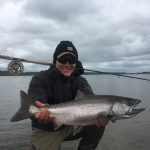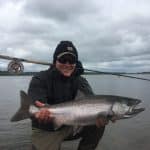On Alaska’s Nushagak River, we do a lot of plug fishing for king salmon. Whether we’re backtrolling plugs for king salmon or trolling plugs in tidally influenced parts of the river for king salmon, we’re always about keeping them clean.
Whether fishing wrapped plugs or not, making the effort to keep plugs clean is of vital importance. Remember, salmon have a sense of smell measured in parts per billion, and the slightest off-odor can turn off a bite, even in Alaska.
Plugs that have been wrapped contain oil remnants from the fillets, and when drying, these residues solidify on the plug, often producing repulsive odors. At the same time, handling plugs with bare hands leaves human oils behind, something which may also make the difference in whether or not a salmon bites a presentation or not.
Prior to placing plugs back in the box at the end of the day, take a few minutes to wash them in hot, soapy water. If you have a sled boat with a hot water basin built in, these are excellent features, and save time by allowing you to wash plugs as they’re used. Simply toss the plugs in the hot water bin, let them soak, then give them a quick scrub-down with a brush and soap.
If you have to wait until you get home–or in our case, back to camp–to wash the plugs, a toothbrush and some aggressive scrubbing is often required to fully remove all unwanted buildup. When done, hang the plugs and allow them to air dry prior to placing them back in the tackle box. If you find yourself on the water and not catching fish, this step can explain why your favorite plug may have quit producing.
If you’re still not getting bites and your plugs are fresh and clean, consider washing your roads, reels, fishing line, even your boat, because each of these things can harbor scents that repel king salmon.










